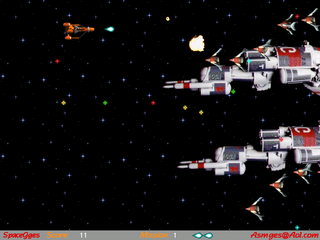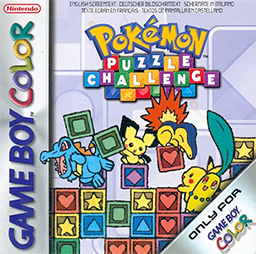
Recreational mathematics is mathematics carried out for recreation (entertainment) rather than as a strictly research and application-based professional activity or as a part of a student's formal education. Although it is not necessarily limited to being an endeavor for amateurs, many topics in this field require no knowledge of advanced mathematics. Recreational mathematics involves mathematical puzzles and games, often appealing to children and untrained adults, inspiring their further study of the subject.
A platform game is a video game genre and subgenre of action games in which the core objective is to move the player character between points in a rendered environment. Platform games are characterized by their level design featuring uneven terrain and suspended platforms of varying height that requires use of the player character's abilities, such as jumping and climbing, to navigate the player's environment and reach their goal. Other acrobatic maneuvers may factor into the gameplay as well, such as swinging from objects such as vines or grappling hooks, jumping off walls, air dashing, gliding through the air, being shot from cannons or bouncing from springboards or trampolines. Games where jumping is automated completely, such as 3D games in The Legend of Zelda series, fall outside of the genre.

Sacred geometry ascribes symbolic and sacred meanings to certain geometric shapes and certain geometric proportions. It is associated with the belief that a god is the creator of the universal geometer. The geometry used in the design and construction of religious structures such as churches, temples, mosques, religious monuments, altars, and tabernacles has sometimes been considered sacred. The concept applies also to sacred spaces such as temenoi, sacred groves, village greens, pagodas and holy wells, Mandala Gardens and the creation of religious and spiritual art.

Tetris Attack, also known as Panel de Pon, is a 1995 puzzle video game developed by Intelligent Systems and published by Nintendo for the Super Nintendo Entertainment System. A Game Boy version was released a year later. In the game, the player must arrange matching colored blocks in vertical or horizontal rows to clear them. The blocks steadily rise towards the top of the playfield, with new blocks being added at the bottom. Several gameplay modes are present, including a time attack and multiplayer mode.
A single-player video game is a video game where input from only one player is expected throughout the course of the gaming session. A single-player game is usually a game that can only be played by one person, while "single-player mode" is usually a game mode designed to be played by a single player, though the game also contains multi-player modes.

A video game genre is a classification assigned to a video game based on its core gameplay rather than visual or narrative features. A video game genre is normally defined by a set of gameplay challenges considered independently of setting or game-world content, unlike works of fiction that are expressed through other media, such as films or books. For example, a shooter game is still a shooter game, regardless of where or when it takes place.

The action-adventure genre is a video game genre that combines core elements from both the action game and adventure game genres.

Pokémon Puzzle League is a 2000 puzzle video game developed for the Nintendo 64 by Nintendo Software Technology based on Nintendo's Puzzle League puzzle games with Pokémon likenesses. It was released in North America in 2000, and in Europe in 2001. Gameplay is similar to Puzzle League, with much of the focus being on puzzle-based strategy in the game's grid-based format. To advance to new levels, players are required to advance through the game's trainers and gym leaders, similar to the ones featured in Pokémon Red, Blue, and Yellow. It is one of several Pokémon games to be based on the Pokémon anime, and features Ash Ketchum and other characters featured from the anime.

Pokémon Puzzle Challenge is a video game for the Game Boy Color. It is based on Panel de Pon, only with characters from the Pokémon franchise. The characters in Pokémon Puzzle Challenge are based on those in the Gold and Silver games, while those in Pokémon Puzzle League—its Nintendo 64 equivalent—were based more on the anime characters. However, the game is also focused around beating the Johto leaders in a puzzle challenge in Johto region. The game play mode is divided into 1 Player, 2 Player, and Training. The game was later released on the 3DS eShop on November 6, 2014.

Super Puzzle Fighter II Turbo, released in Japan as Super Puzzle Fighter II X, is a one or two player tile-matching puzzle video game first released in 1996 for the CP System II (CPS2) arcade board, by Capcom and its Capcom Coin-Op division. The game's title is a parody of Super Street Fighter II Turbo, as there were no other Puzzle Fighter games at the time, and the game includes music and interface elements spoofing the Street Fighter Alpha and Darkstalkers games. It was a response to Sega's Puyo Puyo 2 that had been sweeping the Japanese arcade scene.

Pac-Attack, also known as Pac-Panic, is a 1993 falling-tile puzzle video game developed and published by Namco for the Super Nintendo Entertainment System and Sega Genesis. Versions for the Game Boy, Game Gear and Philips CD-i were also released. The player is tasked with clearing out blocks and ghosts without them stacking to the top of the playfield — blocks can be cleared by matching them in horizontal rows, while ghosts can be cleared by placing down a Pac-Man piece that can eat them. It is the first game in the Pac-Man series to be released exclusively for home platforms.

Girih are decorative Islamic geometric patterns used in architecture and handicraft objects, consisting of angled lines that form an interlaced strapwork pattern.
A sandbox game is a video game with a gameplay element that provides the player a great degree of creativity to interact with, usually without any predetermined goal, or alternatively with a goal that the player sets for themselves. Such games may lack any objective, and are sometimes referred to as non-games or software toys. More often, sandbox games result from these creative elements being incorporated into other genres and allowing for emergent gameplay. Sandbox games are often associated with an open world concept which gives the player freedom of movement and progression in the game's world. The "sandbox" term derives from the nature of a sandbox that lets children create nearly anything they want within it.

Geometry Wars: Retro Evolved 2 is a multidirectional shooter video game created by Bizarre Creations, released on Xbox Live Arcade on July 30, 2008 as a sequel to Geometry Wars: Retro Evolved.

Galaga Legions is a 2008 twin-stick shooter video game developed and released by Namco Bandai Games for the Xbox 360. It is the twelfth game in the Galaxian series, and the third developed for home platforms. The player controls a starship, the AEf-7 "Blowneedle", in its efforts to wipe out the Galaga armada. The objective of the game is to clear each of the five stages as quick as possible. Stages have a heavy emphasis on puzzle solving and chain reactions, which are necessary to clear out enemy formations. The Blowneedle has a pair of satellites at its disposal, and can place them anywhere on the screen to fend off enemies.

Islamic geometric patterns are one of the major forms of Islamic ornament, which tends to avoid using figurative images, as it is forbidden to create a representation of an important Islamic figure according to many holy scriptures.

The Topkapı Scroll is a Timurid dynasty pattern scroll in the collection of the Topkapı Palace museum.

Serious Sam: The Random Encounter is a 2011 role-playing and bullet hell game developed by Vlambeer and published by Devolver Digital. It follows Sam "Serious" Stone travelling to the future in search of his nemesis, Mental, teaming up with mercenaries on the way. The player controls Sam and his accomplices through confined levels, engaging in battles through random encounters. These pit the player characters against large waves of enemies, and the player controls the weapons and items each character uses against them in five-second turns.

HyperRogue is an independent video game developed by Zeno Rogue. It is a roguelike inspired by the puzzle game Deadly Rooms of Death and the art of M. C. Escher, taking place in the hyperbolic plane.
Mahdi Bahrami is an Iranian computer programmer, video game designer and developer.















